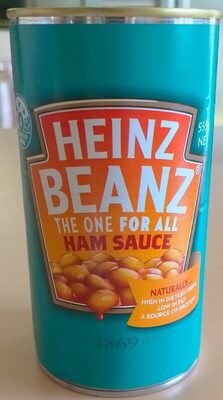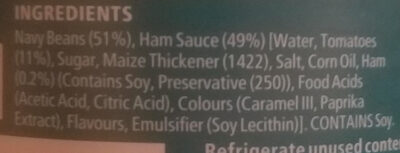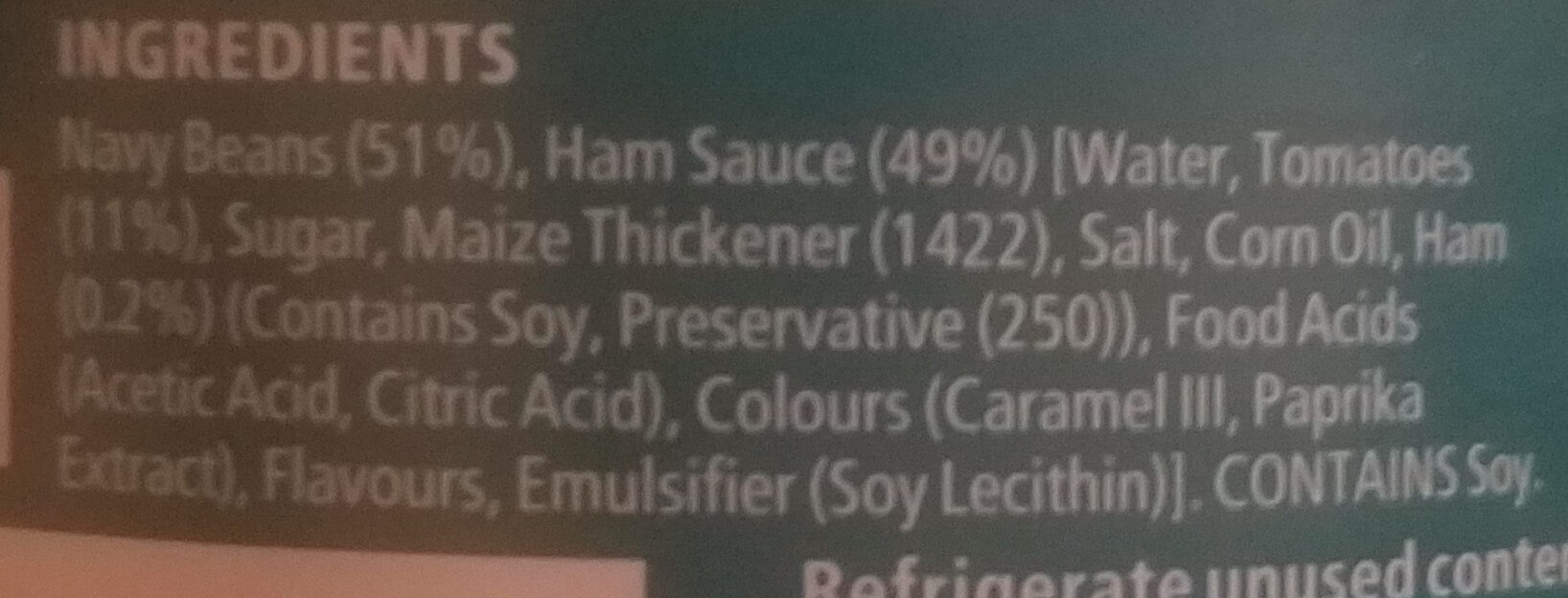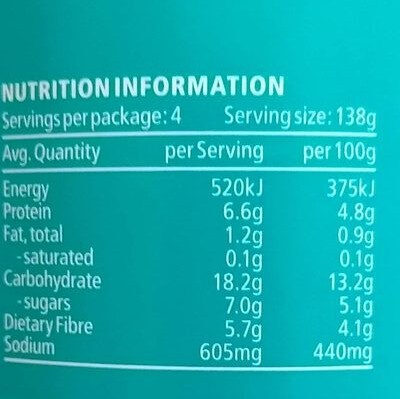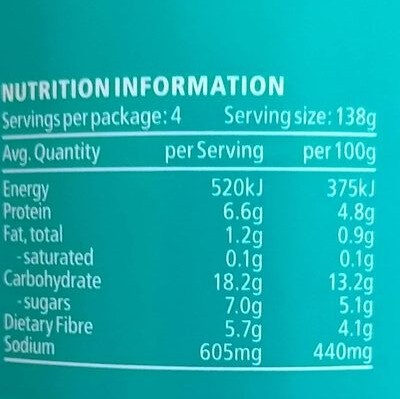Help us make food transparency the norm!
As a non-profit organization, we depend on your donations to continue informing consumers around the world about what they eat.
The food revolution starts with you!
Beans ham sauce - Heinz - 555g
Beans ham sauce - Heinz - 555g
This product page is not complete. You can help to complete it by editing it and adding more data from the photos we have, or by taking more photos using the app for Android or iPhone/iPad. Thank you!
×
Barcode: 9300657234881 (EAN / EAN-13)
Quantity: 555g
Packaging: Canned
Brands: Heinz
Categories: Plant-based foods and beverages, Plant-based foods, Meals, Prepared vegetables, Baked beans in tomato sauce
Labels, certifications, awards:
Health Star Rating, Health Star Rating 4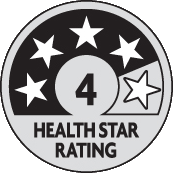
Manufacturing or processing places: New Zealand
Stores: Woolworths, Coles
Countries where sold: Australia
Matching with your preferences
Health
Ingredients
-
21 ingredients
Navy Beans (51%), Ham Sauce (49%) [Water, Tomatoes (11%), Sugar, Maize Thickener (1422), Salt, Corn Oil, Ham (0.2%) (Contains Soy, Preservative (250)), Food Acids (Acetic Acid, Citric Acid), Colours (Caramel III, Paprika Extract), Flavours, Emulsifier (Soy Lecithin)]. CONTAINS Soy.Allergens: SoybeansTraces: Soybeans
Food processing
-
Ultra processed foods
Elements that indicate the product is in the 4 - Ultra processed food and drink products group:
- Additive: E1422 - Acetylated distarch adipate
- Additive: E160c - Paprika extract
- Additive: E322 - Lecithins
- Ingredient: Colour
- Ingredient: Emulsifier
- Ingredient: Flavouring
Food products are classified into 4 groups according to their degree of processing:
- Unprocessed or minimally processed foods
- Processed culinary ingredients
- Processed foods
- Ultra processed foods
The determination of the group is based on the category of the product and on the ingredients it contains.
Additives
-
E1422 - Acetylated distarch adipate
Acetylated distarch adipate: Acetylated distarch adipate -E1422-, is a starch that is treated with acetic anhydride and adipic acid anhydride to resist high temperatures. It is used in foods as a bulking agent, stabilizer and a thickener. No acceptable daily intake for human consumption has been determined.Source: Wikipedia
-
E250 - Sodium nitrite
Sodium nitrite: Sodium nitrite is the inorganic compound with the chemical formula NaNO2. It is a white to slightly yellowish crystalline powder that is very soluble in water and is hygroscopic. It is a useful precursor to a variety of organic compounds, such as pharmaceuticals, dyes, and pesticides, but it is probably best known as a food additive to prevent botulism. It is on the World Health Organization's List of Essential Medicines, the most important medications needed in a basic health system.Nitrate or nitrite -ingested- under conditions that result in endogenous nitrosation has been classified as "probably carcinogenic to humans" by International Agency for Research on Cancer -IARC-.Source: Wikipedia
-
E260 - Acetic acid
Acetic acid: Acetic acid , systematically named ethanoic acid , is a colorless liquid organic compound with the chemical formula CH3COOH -also written as CH3CO2H or C2H4O2-. When undiluted, it is sometimes called glacial acetic acid. Vinegar is no less than 4% acetic acid by volume, making acetic acid the main component of vinegar apart from water. Acetic acid has a distinctive sour taste and pungent smell. In addition to household vinegar, it is mainly produced as a precursor to polyvinyl acetate and cellulose acetate. It is classified as a weak acid since it only partially dissociates in solution, but concentrated acetic acid is corrosive and can attack the skin. Acetic acid is the second simplest carboxylic acid -after formic acid-. It consists of a methyl group attached to a carboxyl group. It is an important chemical reagent and industrial chemical, used primarily in the production of cellulose acetate for photographic film, polyvinyl acetate for wood glue, and synthetic fibres and fabrics. In households, diluted acetic acid is often used in descaling agents. In the food industry, acetic acid is controlled by the food additive code E260 as an acidity regulator and as a condiment. In biochemistry, the acetyl group, derived from acetic acid, is fundamental to all forms of life. When bound to coenzyme A, it is central to the metabolism of carbohydrates and fats. The global demand for acetic acid is about 6.5 million metric tons per year -Mt/a-, of which approximately 1.5 Mt/a is met by recycling; the remainder is manufactured from methanol. Vinegar is mostly dilute acetic acid, often produced by fermentation and subsequent oxidation of ethanol.Source: Wikipedia
-
E322 - Lecithins
Lecithins are natural compounds commonly used in the food industry as emulsifiers and stabilizers.
Extracted from sources like soybeans and eggs, lecithins consist of phospholipids that enhance the mixing of oil and water, ensuring smooth textures in various products like chocolates, dressings, and baked goods.
They do not present any known health risks.
-
E322i - Lecithin
Lecithins are natural compounds commonly used in the food industry as emulsifiers and stabilizers.
Extracted from sources like soybeans and eggs, lecithins consist of phospholipids that enhance the mixing of oil and water, ensuring smooth textures in various products like chocolates, dressings, and baked goods.
They do not present any known health risks.
-
E330 - Citric acid
Citric acid is a natural organic acid found in citrus fruits such as lemons, oranges, and limes.
It is widely used in the food industry as a flavor enhancer, acidulant, and preservative due to its tart and refreshing taste.
Citric acid is safe for consumption when used in moderation and is considered a generally recognized as safe (GRAS) food additive by regulatory agencies worldwide.
Ingredients analysis
-
Palm oil content unknown
Unrecognized ingredients: Ham-sauce, Maize-thickener, 1422, 250, Food-acids, Caramel-iiiSome ingredients could not be recognized.
We need your help!
You can help us recognize more ingredients and better analyze the list of ingredients for this product and others:
- Edit this product page to correct spelling mistakes in the ingredients list, and/or to remove ingredients in other languages and sentences that are not related to the ingredients.
- Add new entries, synonyms or translations to our multilingual lists of ingredients, ingredient processing methods, and labels.
If you would like to help, join the #ingredients channel on our Slack discussion space and/or learn about ingredients analysis on our wiki. Thank you!
-
Non-vegan
Non-vegan ingredients: HamSome ingredients could not be recognized.
We need your help!
You can help us recognize more ingredients and better analyze the list of ingredients for this product and others:
- Edit this product page to correct spelling mistakes in the ingredients list, and/or to remove ingredients in other languages and sentences that are not related to the ingredients.
- Add new entries, synonyms or translations to our multilingual lists of ingredients, ingredient processing methods, and labels.
If you would like to help, join the #ingredients channel on our Slack discussion space and/or learn about ingredients analysis on our wiki. Thank you!
-
Non-vegetarian
Non-vegetarian ingredients: HamSome ingredients could not be recognized.
We need your help!
You can help us recognize more ingredients and better analyze the list of ingredients for this product and others:
- Edit this product page to correct spelling mistakes in the ingredients list, and/or to remove ingredients in other languages and sentences that are not related to the ingredients.
- Add new entries, synonyms or translations to our multilingual lists of ingredients, ingredient processing methods, and labels.
If you would like to help, join the #ingredients channel on our Slack discussion space and/or learn about ingredients analysis on our wiki. Thank you!
-
Details of the analysis of the ingredients
We need your help!
Some ingredients could not be recognized.
We need your help!
You can help us recognize more ingredients and better analyze the list of ingredients for this product and others:
- Edit this product page to correct spelling mistakes in the ingredients list, and/or to remove ingredients in other languages and sentences that are not related to the ingredients.
- Add new entries, synonyms or translations to our multilingual lists of ingredients, ingredient processing methods, and labels.
If you would like to help, join the #ingredients channel on our Slack discussion space and/or learn about ingredients analysis on our wiki. Thank you!
: Navy Beans 51%, Ham Sauce 49% (Water, Tomatoes 11%, Sugar, Maize Thickener (1422), Salt, Corn Oil, Ham 0.2% (Preservative (250)), Food Acids (Acetic Acid, Citric Acid), Colours (Caramel III, Paprika Extract), Flavours, Emulsifier (Soy Lecithin))- Navy Beans -> en:white-beans - vegan: yes - vegetarian: yes - percent_min: 51 - percent: 51 - percent_max: 51
- Ham Sauce -> en:ham-sauce - percent_min: 49 - percent: 49 - percent_max: 49
- Water -> en:water - vegan: yes - vegetarian: yes - ciqual_food_code: 18066 - percent_min: 24.66 - percent_max: 37
- Tomatoes -> en:tomato - vegan: yes - vegetarian: yes - ciqual_food_code: 20047 - percent_min: 11 - percent: 11 - percent_max: 11
- Sugar -> en:sugar - vegan: yes - vegetarian: yes - ciqual_proxy_food_code: 31016 - percent_min: 0.2 - percent_max: 5.07
- Maize Thickener -> en:maize-thickener - percent_min: 0.2 - percent_max: 5.07
- 1422 -> en:1422 - percent_min: 0.2 - percent_max: 5.07
- Salt -> en:salt - vegan: yes - vegetarian: yes - ciqual_food_code: 11058 - percent_min: 0.2 - percent_max: 1.1
- Corn Oil -> en:corn-oil - vegan: yes - vegetarian: yes - from_palm_oil: no - ciqual_food_code: 17190 - percent_min: 0.2 - percent_max: 1.1
- Ham -> en:ham - vegan: no - vegetarian: no - ciqual_proxy_food_code: 28205 - percent_min: 0.2 - percent: 0.2 - percent_max: 0.2
- Preservative -> en:preservative - percent_min: 0.2 - percent_max: 0.2
- 250 -> en:250 - percent_min: 0.2 - percent_max: 0.2
- Preservative -> en:preservative - percent_min: 0.2 - percent_max: 0.2
- Food Acids -> en:food-acids - percent_min: 0 - percent_max: 0.2
- Acetic Acid -> en:e260 - vegan: yes - vegetarian: yes - percent_min: 0 - percent_max: 0.2
- Citric Acid -> en:e330 - vegan: yes - vegetarian: yes - percent_min: 0 - percent_max: 0.2
- Colours -> en:colour - percent_min: 0 - percent_max: 0.2
- Caramel III -> en:caramel-iii - percent_min: 0 - percent_max: 0.2
- Paprika Extract -> en:e160c - vegan: yes - vegetarian: yes - percent_min: 0 - percent_max: 0.2
- Flavours -> en:flavouring - vegan: maybe - vegetarian: maybe - percent_min: 0 - percent_max: 0.2
- Emulsifier -> en:emulsifier - percent_min: 0 - percent_max: 0.2
- Soy Lecithin -> en:soya-lecithin - vegan: yes - vegetarian: yes - ciqual_food_code: 42200 - percent_min: 0 - percent_max: 0.2
Nutrition
-
Very good nutritional quality
⚠ ️Warning: the amount of fruits, vegetables and nuts is not specified on the label, it was estimated from the list of ingredients: 62This product is not considered a beverage for the calculation of the Nutri-Score.
Positive points: 8
- Proteins: 2 / 5 (value: 4.78, rounded value: 4.78)
- Fiber: 4 / 5 (value: 4.1, rounded value: 4.1)
- Fruits, vegetables, nuts, and colza/walnut/olive oils: 2 / 5 (value: 62, rounded value: 62)
Negative points: 6
- Energy: 1 / 10 (value: 375, rounded value: 375)
- Sugars: 1 / 10 (value: 5.07, rounded value: 5.1)
- Saturated fat: 0 / 10 (value: 0.07, rounded value: 0.1)
- Sodium: 4 / 10 (value: 440, rounded value: 440)
The points for proteins are counted because the negative points are less than 11.
Nutritional score: (6 - 8)
Nutri-Score:
-
Nutrient levels
-
Fat in low quantity (0.87%)
What you need to know- A high consumption of fat, especially saturated fats, can raise cholesterol, which increases the risk of heart diseases.
Recommendation: Limit the consumption of fat and saturated fat- Choose products with lower fat and saturated fat content.
-
Saturated fat in low quantity (0.07%)
What you need to know- A high consumption of fat, especially saturated fats, can raise cholesterol, which increases the risk of heart diseases.
Recommendation: Limit the consumption of fat and saturated fat- Choose products with lower fat and saturated fat content.
-
Sugars in moderate quantity (5.07%)
What you need to know- A high consumption of sugar can cause weight gain and tooth decay. It also augments the risk of type 2 diabetes and cardio-vascular diseases.
Recommendation: Limit the consumption of sugar and sugary drinks- Sugary drinks (such as sodas, fruit beverages, and fruit juices and nectars) should be limited as much as possible (no more than 1 glass a day).
- Choose products with lower sugar content and reduce the consumption of products with added sugars.
-
Salt in moderate quantity (1.1%)
What you need to know- A high consumption of salt (or sodium) can cause raised blood pressure, which can increase the risk of heart disease and stroke.
- Many people who have high blood pressure do not know it, as there are often no symptoms.
- Most people consume too much salt (on average 9 to 12 grams per day), around twice the recommended maximum level of intake.
Recommendation: Limit the consumption of salt and salted food- Reduce the quantity of salt used when cooking, and don't salt again at the table.
- Limit the consumption of salty snacks and choose products with lower salt content.
-
-
Nutrition facts
Nutrition facts As sold
for 100 g / 100 mlAs sold
per serving (138g)Compared to: Baked beans in tomato sauce Energy 375 kj
(90 kcal)518 kj
(124 kcal)- Fat 0.87 g 1.2 g +55% Saturated fat 0.07 g 0.097 g -24% Carbohydrates 13.19 g 18.2 g +1% Sugars 5.07 g 7 g +6% Fiber 4.1 g 5.66 g -9% Proteins 4.78 g 6.6 g -1% Salt 1.1 g 1.52 g +53% Fruits‚ vegetables‚ nuts and rapeseed‚ walnut and olive oils (estimate from ingredients list analysis) 62 % 62 %
Environment
-
Eco-Score B - Low environmental impact
⚠ ️The full impact of transportation to your country is currently unknown.The Eco-Score is an experimental score that summarizes the environmental impacts of food products.→ The Eco-Score was initially developped for France and it is being extended to other European countries. The Eco-Score formula is subject to change as it is regularly improved to make it more precise and better suited to each country.Life cycle analysis
-
Average impact of products of the same category: A (Score: 97/100)
Category: Haricot beans with tomato sauce, canned
Category: Haricot beans with tomato sauce, canned
- PEF environmental score: 0.10 (the lower the score, the lower the impact)
- including impact on climate change: 0.61 kg CO2 eq/kg of product
Stage Impact Agriculture
50.1 %Processing
16.2 %Packaging
15.2 %Transportation
10.0 %Distribution
4.5 %Consumption
4.0 %
Bonuses and maluses
-
Missing origins of ingredients information
Malus:
⚠ ️ The origins of the ingredients of this product are not indicated.
If they are indicated on the packaging, you can modify the product sheet and add them.
If you are the manufacturer of this product, you can send us the information with our free platform for producers.
-
Missing packaging information for this product
Malus: -15
⚠ ️ The information about the packaging of this product is not filled in.⚠ ️ For a more precise calculation of the Eco-Score, you can modify the product page and add them.
If you are the manufacturer of this product, you can send us the information with our free platform for producers.
Eco-Score for this product
-
Impact for this product: B (Score: 77/100)
Product: Beans ham sauce - Heinz - 555g
Life cycle analysis score: 97
Sum of bonuses and maluses: -15
Final score: 77/100
-
Carbon footprint
-
Equal to driving 0.3 km in a petrol car
61 g CO² per 100g of product
The carbon emission figure comes from ADEME's Agribalyse database, for the category: Haricot beans with tomato sauce, canned (Source: ADEME Agribalyse Database)
Stage Impact Agriculture
16.6 %Processing
29.6 %Packaging
28.8 %Transportation
20.6 %Distribution
2.6 %Consumption
1.8 %
Packaging
-
Missing packaging information for this product
⚠ ️ The information about the packaging of this product is not filled in.Take a photo of the recycling information Take a photo of the recycling information
Transportation
-
Origins of ingredients
Missing origins of ingredients information
⚠ ️ The origins of the ingredients of this product are not indicated.
If they are indicated on the packaging, you can modify the product sheet and add them.
If you are the manufacturer of this product, you can send us the information with our free platform for producers.Add the origins of ingredients for this product Add the origins of ingredients for this product
Report a problem
-
Incomplete or incorrect information?
Category, labels, ingredients, allergens, nutritional information, photos etc.
If the information does not match the information on the packaging, please complete or correct it. Open Food Facts is a collaborative database, and every contribution is useful for all.
Data sources
Product added on by clockwerx
Last edit of product page on by archanox.
Product page also edited by ecoscore-impact-estimator, katew, kiliweb, openfoodfacts-contributors, packbot, roboto-app, yuka.sY2b0xO6T85zoF3NwEKvlhBjeuDF-y_pajzhxFKN1o2EMZXiZcFI2Jbea6o.
